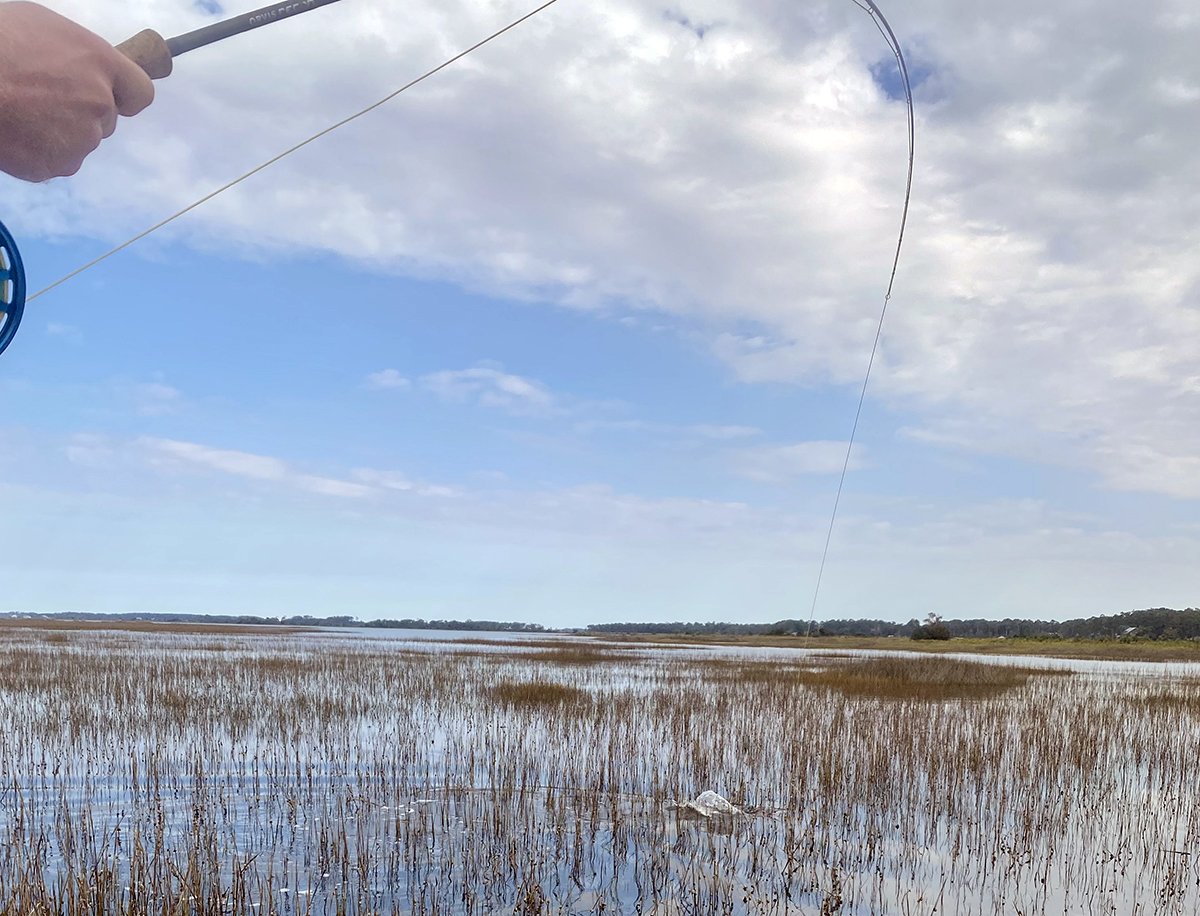The “eyes” on the wings of Polyphemus moth are meant to trick birds and other predators.
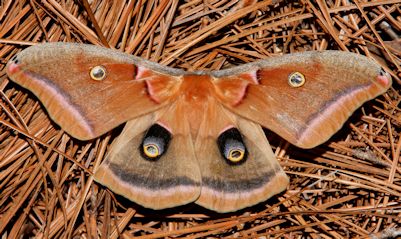 An adult Polyphemus moth lives about a week after emerging from its cocoon. With no digestive track or mouth parts, it can’t eat. It’s only function is to mate. |
EMERALD ISLE — A Cyclops stayed at my house. You remember the Cyclops from Greek mythology, those giants with one eye in the middle of their forehead? The poet Homer brought to life the nasty man-eating giant Cyclops, Polyphemus, in his book Odyssey. My Cyclops, though, was no problem at all; it built a snug little room outside, and kept to itself.
Supporter Spotlight
The Polyphemus that I came to know first showed up in the fall last year in the form of a plump, neon green, three-inch caterpillar crawling up the path to my house. This insect was in the final stage as a caterpillar before beginning the process of metamorphosis to become a moth.
After hatching from a tiny egg, the Polyphemus larvae will ravenously begin consuming the leaves of a host plant such as the willow trees in my yard. As they grow, the caterpillar will molt, shedding their exterior covering five times. The sloughed off skin, which contains valuable nutrients, is also consumed.
Due to the size and color of this bug, I knew that it was either a Luna moth or a Polyphemus moth caterpillar. Both of these caterpillars look very much alike; however, I nailed this one down as a Polyphemus due to its vertical yellow striping. The Luna caterpillar, on the other hand, has a horizontal side stripe.
Photos bySam Bland |
The visitor wandering around outside my house was looking for a spot to hunker down for a long winter. It might seem odd that the caterpillar would leave the safety of the trees to seek out a new unfamiliar location to build its cocoon. They are now vulnerable, and the presence of these caterpillars is betrayed by the presence of chewed up leaves and droppings, called frass, that will surely tip off a hungry bird looking for a meal. Its green coloration can provide some camouflage, but when threatened, it will snap its mouth parts and its final defense is to throw up a nasty tasting liquid that rejects even the hungriest bird.
It meandered off the path and made its way up to the leaves of a small oleander bush. Here, it began to crawl around back and forth around a clump of leaves. It appeared that its mouth parts were on the edge of the leaves and it was continuing to browse. However, I noticed that the leaves were not chewed on at all. Through my camera lens, on micro setting, I could see the head and mouth parts up close and got a case of the heebie-jeebies. This was a nasty looking face that could easily be the inspiration for a B-grade creature feature.
Supporter Spotlight
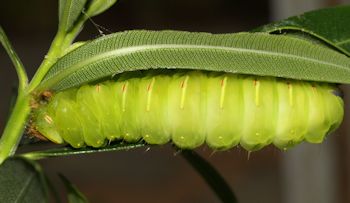 The plump moth caterpillar will ravenously feed on plants before weaving its cocoon. |
It continued moving around a cluster of four leaves and I noticed some stringy web-like material being emitted near the mouth that coated the edges of the leaves. It then crawled and sandwiched itself horizontally between two of the leaves and then reached up and pulled down a third leaf, and then the fourth leaf, to wrap around as much exposed flesh as possible. The stringy coating is the silk produced by this family of moths, very much the same as what is found in commercially produced silk. Even today, some people collect hatched out cocoons to produce silk yarn. The silk is made of two proteins, sericin and fibroin. The fibroin provides the structure while the sericin provides the stickiness necessary for good adhesion. Silk sericin is used in the cosmetic industry for skin creams and hair conditioners to prevent moisture loss. It is thought to have been used for over 3,500 years to address the vanities of the human body.
As the light was ebbing from the sky, the caterpillar was soon wrapped up like a leafy egg roll. The next morning I checked on the caterpillar and a complete greenish cocoon encased the creature which was now transforming into the pupa stage. In a few days, the greenish color of the cocoon faded into a chalky white. Since this insect was going to have to wait out the next seven months until spring, the pupa was now in a state called diapause, like a form of hibernation.
I checked the cocoon over the months to make sure that it had not been discovered by any predators such as a squirrel or raccoon. It endured many rainy, windy and freezing days during an arctic cold winter by coastal North Carolina standards. On a few occasions, the freezing rain created an icy “cocoonsicle.” But the cocoon and pupa shell kept the critter tight and dry and the cold temperatures were not even an annoyance. The pupa is loaded with an antifreeze-like substance called glycerol, basically alcohol and sugar, which protects it from freezing down to minus forty degrees.
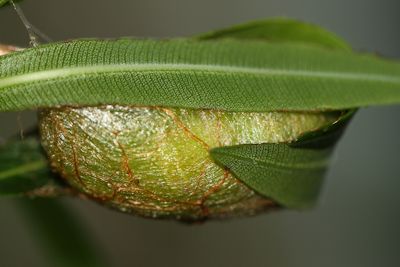 A new cocoon, top. One that is several months old, left, and an empty cocoon after the moth has emerged. |
|
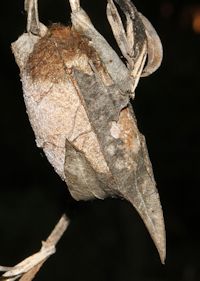 |
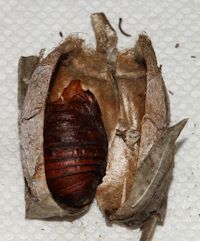 |
The days came and went and the cocoon showed the battering of the harsh coastal elements. The cold winter had even killed the small oleander and I had to bind the supporting branch with duct tape to keep the cocoon off the ground.
I pretty much had given up hope on the visitor in the yard. Then, late one warm spring afternoon as I was walking up to the house, I noticed a fresh beautiful five inch Polyphemus moth along the edge of the pathway only a foot or two away from the dead oleander bush. I quickly checked the cocoon and it still looked firm and intact. But upon a second inspection of the cocoon I discovered a very small hole at the top of the casing. To escape its winter home, the new moth produces an enzyme substance called cocoonase that will tenderize the tough silk. Then, using two small thorn-like barbs, it will wallow out an escape opening to squeeze through and out into the same world, but with a different body.
Polyphemus had now arrived and the relationship to its name was staring right at me. Two large exotic looking “eyes” were on the hind wings while two smaller silver “eyes” were on the forewings. These eyes are their predator defense mechanism that is part of a camouflage system designed to startle and distract predators.
Its small slender antennae and ample egg-filled abdomen indicated that this was a female. A male has a smaller abdomen and large feather-like antennae. The male Polyphemus will emerge a few days before to be available when the ladies arrive.
After about an hour, the female crawled over to the stalk of a jasmine vine and climbed up into the leaves about five feet up. As soon as the sky darkened, she began releasing a potent pheromone that the males can detect over a mile away. This moth perfume is so effective that the female will just sit back and wait knowing that an eager male will be attracted within hours. Sure enough, the following morning I was up before the sun and used a flashlight to discover that a male was with the female.
And that is pretty much what adult Polyphemus moths do. They lack mouth parts as well as a digestive tract and thus, they do not eat. After mating, the male will go in search of other females and the female will go about scattering her fertilized tan-ish colored eggs. But their procreation duties are over all too soon as they only live as an adult for about a week. Unless they overwinter as a pupa, their entire life span is only around three months.
Later that morning, the moths were gone and I suppose that the female was depositing some eggs here and there on the willow and oak trees. I will soon be checking the trees for the caterpillars and in a few weeks I hope to find a few of the cocoons that hold the magic and beauty of transformation.






